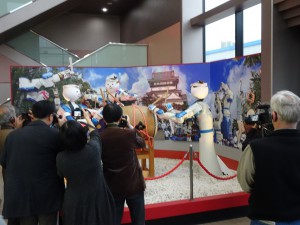Date : March 17 - 18, 2016
Report: Press Tour to Kitakyushu City “The Front Line of the Future of Energy Use in Japan”
post date : 2016.05.24
This press tour visited Kitakyushu City a month and a half ahead of the G7 Energy Ministers Meeting, covering topics such as cutting-edge initiatives for reducing CO2 emissions. Ten journalists joined the tour, from Bangladesh, China, France, Germany, South Korea, Taiwan, and the USA.
Click here for further details on the tour
Click here for a log of real-time updates from during the tour.
【Day 1】
1. Kitakyushu Environment Museum
The museum’s director, Mr. Nakazono, explained the history of industrial pollution in Kitakyushu as he guided the tour around the museum, speaking about how it was efforts by citizens, particularly women’s groups, which pushed the city to deal with its pollution issues. That spirit still exists today, and the city’s efforts on environmental improvement and international cooperation led to it being added to the United Nations Environment Programme’s Global 500 Roll of Honour, which is a source of pride for the city’s residents. The journalists asked questions about whether the pollution affected people’s health or caused the birth rate to decline, how many years it took before citizens felt like the pollution had been overcome, and whether the government or corporations opposed the women who first argued for something to be done about the pollution. Mr. Kumai and Mr. Toyozawa, volunteers who remember what the pollution was like at the time, described it to the journalists as they listened intently.
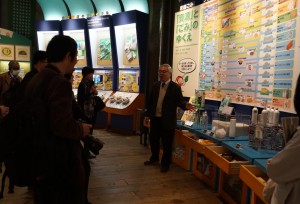
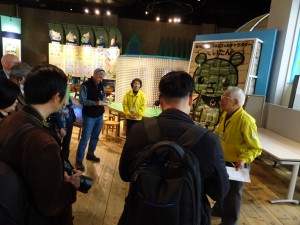
2. Hydrogen Town, Higashida Smart Community, Cluster Energy Management System Control Room
Mr. Atsushi Tahara from Kitakyushu City’s Environment Bureau guided the tour around the Higashida district where a hydrogen supply pipeline had been tested, and they photographed spots that were supplied with hydrogen, such as housing complexes and hydrogen stations. At the Cluster Energy Management System control room, effectively the command center of the smart community, the journalists listened to a detailed explanation of the trial experiment. Regarding the city’s cutting-edge initiatives, journalists asked whether there was any opposition from the local power company over the smart community initiatives, and how those issues were dealt with; how the city managed to finance the trial; and what issues remain to be solved to ensure the safety of hydrogen fuel. The journalists also photographed and filmed the Cluster Energy Management System control room, where the town’s energy consumption is presented in a clearly visible way.
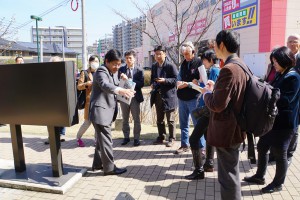
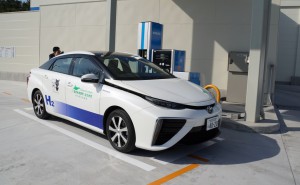
3. Interview with Kitakyushu Mayor
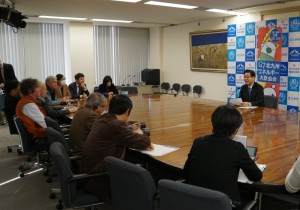 Working off the information they gathered at the Environment Museum and in Higashida (Hydrogen Town and Smart Community), the journalists asked the mayor about a number of topics: the next step for Kitakyushu City as a green city; arguments for and against nuclear power; the aging population, declining birthrate, and accepting foreign immigrants; use of the National Strategic Special Zone; issues in realizing a hydrogen-based society; hopes regarding the G7 Energy Ministers Meeting; and the role of Kitakyushu City. In response to these questions, Mayor Kitahashi explained his desire to implement bold policies, such as contributing to global environmental conservation by sharing with other Asian countries the experience and knowhow that Kitakyushu City gained from overcoming industrial pollution, and taking advantage of the Special Zone’s relaxed restrictions to establish an environment where it is possible for foreigners to establish companies and undertake sufficient technical training. On the topic of a hydrogen-based society, the mayor mentioned there are issues of reducing costs and ensuring safety, but that he would like to make the athletes’ village for the 2020 Tokyo Olympics and Paralympics the second step towards achieving this society. He also spoke about using Kitakyushu’s experience in having transformed from a polluted city to a city with advanced energy and environmental initiatives at the G7 Energy Ministers Meeting, by presenting various ideas for using energy smartly.
Working off the information they gathered at the Environment Museum and in Higashida (Hydrogen Town and Smart Community), the journalists asked the mayor about a number of topics: the next step for Kitakyushu City as a green city; arguments for and against nuclear power; the aging population, declining birthrate, and accepting foreign immigrants; use of the National Strategic Special Zone; issues in realizing a hydrogen-based society; hopes regarding the G7 Energy Ministers Meeting; and the role of Kitakyushu City. In response to these questions, Mayor Kitahashi explained his desire to implement bold policies, such as contributing to global environmental conservation by sharing with other Asian countries the experience and knowhow that Kitakyushu City gained from overcoming industrial pollution, and taking advantage of the Special Zone’s relaxed restrictions to establish an environment where it is possible for foreigners to establish companies and undertake sufficient technical training. On the topic of a hydrogen-based society, the mayor mentioned there are issues of reducing costs and ensuring safety, but that he would like to make the athletes’ village for the 2020 Tokyo Olympics and Paralympics the second step towards achieving this society. He also spoke about using Kitakyushu’s experience in having transformed from a polluted city to a city with advanced energy and environmental initiatives at the G7 Energy Ministers Meeting, by presenting various ideas for using energy smartly.
4. Reif Co., Ltd.
The first day of the tour ended with a visit to Reif Co., Ltd., a startup company working on building nursing care robots, to cover the walking rehabilitation assistance robot Tree that the company has developed. After hearing an explanation from Mr. Mori, the company president, journalists asked questions about what led to the development of Tree, what responses there have been from people that used it, what hopes he has with Kitakyushu City’s status as a Nursing-care Robot Special Zone, why he decided to go independent and establish a company when he was already working as an engineer for a major corporation, and whether receiving subsidies from the government for research and development costs would cause them to lose the freedom they have in deciding what to develop as a startup.

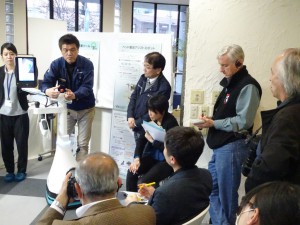
<Day 2>
5. TOTO Museum
The journalists looked at the displays in the museum, learning about the evolution of toilets and how TOTO’s technological innovations had contributed to water- and energy-efficient toilets, and improved the quality of life in Japan. This was followed by Mr. Abe, a Managing Executive Officer at TOTO Ltd., explaining TOTO’s brand strategy and future plans for its overseas business. The journalists asked about efforts in advertising warm-water bidet toilet seats overseas, developing the market in South Asia and the Middle East, changes in the number of Washlet sales with the increased number of foreign tourists in Japan, and toilets in airplanes and Shinkansen trains. The museum opened to commemorate the 100th anniversary of TOTO’s founding, and so has 100 environmentally-friendly measures in place, which drew the journalists’ interest.

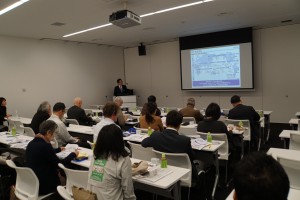
6. J-Power Wakamatsu Laboratory
First, the tour received an explanation that since J-Power is a company that emits CO2, it is working on technology to increase heat efficiency and decrease CO2 emissions, as well as developing technology to manufacture green oil. Next, lead researcher Dr. Matsumoto explained their research into manufacturing green oil from marine algae. The journalists listened with interest to his explanation, and asked about subsidies from the government and uses for the algae that is left over after the oil is extracted. Dr. Matsumoto spoke about how even if was difficult, he would continuing working to achieve the ideal of a low-energy, low-cost process to manufacture green oil. The tour then saw where the algae is cultivated outside, and the cultivation facility currently under construction that will be 40 meters in diameter.
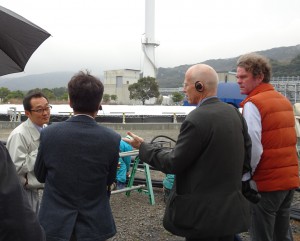

7. Yaskawa Electric Corporation
The two-day tour to Kitakyushu City ended with a visit to Yaskawa Electric Corporation, which celebrated the 100th anniversary of its establishment last year. Mr. Okabayashi, director of the Yaskawa Innovation Center which opened last year, explained the history of the company and about the Innovation Center. The journalists then saw the Innovation Center and a construction plant manufacturing industrial robots. The journalists took notes of Mr. Okabayashi’s explanations while also taking photos of the various robots. After visiting the factory, Mr. Hayashida, the head of Advertising and IR, gave a briefing on the businesses the company is operating in 28 countries throughout the world. Questions from the journalists covered a variety of topics, including what benefits there were from Abenomics, examples of where industrial robots are used, connections with the automobile sector, initiatives of Yaskawa Electric Corporation working towards the fourth industrial revolution (Industry 4.0), artificial intelligence, and issues for coexistence of people and robots o the manufacturing floor.

